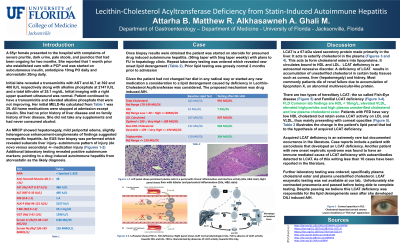Back


Poster Session E - Tuesday Afternoon
Category: Liver
E0558 - Lecithin-Cholesterol Acyltransferase Deficiency From Statin-Induced Autoimmune Hepatitis
Tuesday, October 25, 2022
3:00 PM – 5:00 PM ET
Location: Crown Ballroom

Has Audio

Barrett O. Attarha, DO
University of Florida College of Medicine
Jacksonville, FL
Presenting Author(s)
Barrett O. Attarha, DO, Reshmi Matthew, DO, Maged P. Ghali, MD
University of Florida College of Medicine, Jacksonville, FL
Introduction: A 65yr female presented to the hospital with complaints of pruritis and fatigue that had been ongoing for two months. Upon admission she was found to have transaminitis with AST and ALT at 392 and 400 respectively. (reference lab values AST 0-37 ; ALT 0-35) along with a total bilirubin of 25.1 mg/dL. (Ref 0-1.2). She reported that 1 month ago she went to a primary care doctor and was started on insulin, a calcium channel blocker and atorvastatin. A liver biopsy was done which revealed subacute liver injury- autoimmune pattern of injury (de novo versus secondary) +/- medication injury. This was confirmed by further positive autoimmune markers suggestive of autoimmune hepatitis.
Case Description/Methods: The patient presented to the ER complaining of intense pruritis, dark urine, pale stools, and jaundice. She had recently started atorvastatin, amlodipine and insulin for newly diagnosed diabetes mellitus and essential hypertension. All home medications were stopped at admission except insulin. She had no prior history of liver disease and no family history of liver disease. She did not take any supplements and had never consumed alcohol. Initial labs revealed a transaminitis with AST and ALT at 392 and 400 IU/L respectively. (reference lab values AST 0-37 ; ALT 0-35 )along with alkaline phosphate at 2147 IU/L. (Ref 44-121). Initial imaging with a right upper quadrant ultrasound was normal. Patient continued to have a transaminitis and elevated alkaline phosphate that were not improving. A MRCP was done which showed hepatomegaly, mild periportal edema, slightly heterogenous enhancement-conglomerate of findings suggests nonspecific hepatitis. An EUS liver biopsy was performed which revealed subacute liver injury- autoimmune pattern of injury (de novo versus secondary) +/- medication injury. Additional laboratory testing revealed positive autoimmune markers; pointing to a drug induced autoimmune hepatitis as the likely diagnosis.
Discussion: Patient was started on prednisone and discharged on a steroid taper once her liver function tests began to improve. She followed up in liver clinic and was noted to have developed hypercholesteremia with total cholesterol of 1,375 MG/DL (Ref 170-199 MG/DL), LDL of 1220 Mg/DL and HDL of 162 MG/DL. A cholesterol esters assay was ordered and referral for genetic testing made for likely acquired lecithin cholesterol acyltransferase deficiency in the setting of statin induced autoimmune hepatitis. Previous cholesterol tests prior to starting atorvastatin were normal.
Disclosures:
Barrett O. Attarha, DO, Reshmi Matthew, DO, Maged P. Ghali, MD. E0558 - Lecithin-Cholesterol Acyltransferase Deficiency From Statin-Induced Autoimmune Hepatitis, ACG 2022 Annual Scientific Meeting Abstracts. Charlotte, NC: American College of Gastroenterology.
University of Florida College of Medicine, Jacksonville, FL
Introduction: A 65yr female presented to the hospital with complaints of pruritis and fatigue that had been ongoing for two months. Upon admission she was found to have transaminitis with AST and ALT at 392 and 400 respectively. (reference lab values AST 0-37 ; ALT 0-35) along with a total bilirubin of 25.1 mg/dL. (Ref 0-1.2). She reported that 1 month ago she went to a primary care doctor and was started on insulin, a calcium channel blocker and atorvastatin. A liver biopsy was done which revealed subacute liver injury- autoimmune pattern of injury (de novo versus secondary) +/- medication injury. This was confirmed by further positive autoimmune markers suggestive of autoimmune hepatitis.
Case Description/Methods: The patient presented to the ER complaining of intense pruritis, dark urine, pale stools, and jaundice. She had recently started atorvastatin, amlodipine and insulin for newly diagnosed diabetes mellitus and essential hypertension. All home medications were stopped at admission except insulin. She had no prior history of liver disease and no family history of liver disease. She did not take any supplements and had never consumed alcohol. Initial labs revealed a transaminitis with AST and ALT at 392 and 400 IU/L respectively. (reference lab values AST 0-37 ; ALT 0-35 )along with alkaline phosphate at 2147 IU/L. (Ref 44-121). Initial imaging with a right upper quadrant ultrasound was normal. Patient continued to have a transaminitis and elevated alkaline phosphate that were not improving. A MRCP was done which showed hepatomegaly, mild periportal edema, slightly heterogenous enhancement-conglomerate of findings suggests nonspecific hepatitis. An EUS liver biopsy was performed which revealed subacute liver injury- autoimmune pattern of injury (de novo versus secondary) +/- medication injury. Additional laboratory testing revealed positive autoimmune markers; pointing to a drug induced autoimmune hepatitis as the likely diagnosis.
Discussion: Patient was started on prednisone and discharged on a steroid taper once her liver function tests began to improve. She followed up in liver clinic and was noted to have developed hypercholesteremia with total cholesterol of 1,375 MG/DL (Ref 170-199 MG/DL), LDL of 1220 Mg/DL and HDL of 162 MG/DL. A cholesterol esters assay was ordered and referral for genetic testing made for likely acquired lecithin cholesterol acyltransferase deficiency in the setting of statin induced autoimmune hepatitis. Previous cholesterol tests prior to starting atorvastatin were normal.
Disclosures:
Barrett Attarha indicated no relevant financial relationships.
Reshmi Matthew indicated no relevant financial relationships.
Maged Ghali indicated no relevant financial relationships.
Barrett O. Attarha, DO, Reshmi Matthew, DO, Maged P. Ghali, MD. E0558 - Lecithin-Cholesterol Acyltransferase Deficiency From Statin-Induced Autoimmune Hepatitis, ACG 2022 Annual Scientific Meeting Abstracts. Charlotte, NC: American College of Gastroenterology.
